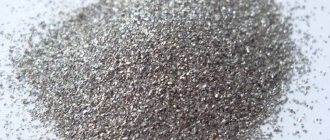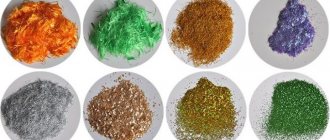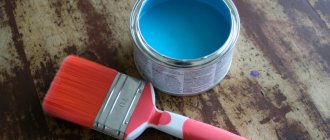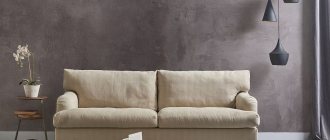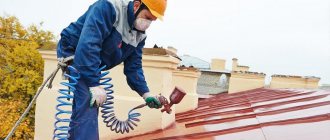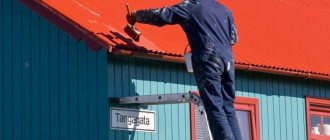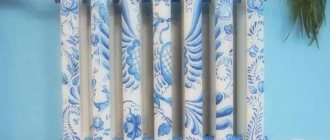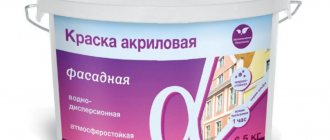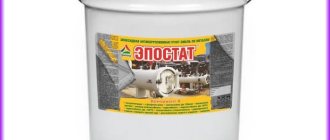The decorative paint was called hammer paint due to the hammering effect that appears on the treated surfaces after drying. The composition was developed for use in laboratories and industrial facilities - where gloss is not required, and metal parts require durable protection from corrosive destruction.
For some time, the advantages of “forged” coating have been appreciated by the owners of private houses and land plots in personal use, and car enthusiasts. Let's talk about what elements paint consists of and how to apply it correctly.
Hammer paints are also called blacksmith paints.
Compound
Modern hammer effect paints solve 3 problems simultaneously:
- Rust conversion . Elimination of iron oxides and inhibition of their growth.
- Anti-corrosion priming . Coating the metal with a film for protection and ensuring adhesion.
- Final enameling . Creation of a stable, leveling layer on the surface.
In most cases the composition contains the following elements:
- Pigments : inorganic dyes with anti-fade properties.
- Binders : acrylic, alkyd resins.
- Solvents : ketone and paraffin compounds.
- Fillers : zinc phosphate, silicone, glass powder, aluminum powder.
It is aluminum powder and a combination of dyes that create an exceptional hammered texture.
Composition and distinctive features
Hammer paint is designed to protect metal products used in industry, production and other areas where they are constantly exposed. Alkyd and epoxy substances are used for its manufacture, which provides exceptional characteristics.
The silicone resins and metal pigments included in the composition guarantee unique durability, ease of application and excellent adhesion to the surface. Due to these components, the density of the paint increases significantly and anti-corrosion properties are achieved.
The strength of the coating is further increased by the fillers present in the composition: fine glass, aluminum powder and others. Thanks to this, not only is the surface durability achieved and adhesion is increased, but also a unique texture is obtained, similar to hand-chasing metal. That is why this product has the property of masking minor defects of the treated surface. Various silicones and “aluminum flakes” are also added to it, which together help improve the texture and increase the ability to repel moisture.
Advantages and disadvantages
The obvious advantages of blacksmith's paint include:
- Effective leveling . Enamel smooths out small defects.
- Rust protection . Protects metal from the formation of iron oxides for 8 years.
- Resistance to high temperatures . A large number of compounds will withstand heating up to + 80 °C.
- Quick drying . The polymerization period for the aerosol application method is no more than 2 hours.
- Decent reliability . Not afraid of vibration, moderate mechanical impacts and hydrometeors.
- Work without lengthy preparation . There is no need to putty or prime the surface. It is enough to remove loose rust.
There were some downsides :
- Low ductility . Where bends and dents develop, small cracks appear where moisture can penetrate.
- Poor compatibility . Without reproaches, they are applied only to coatings with a similar base of binding elements.
Main advantages
This material is characterized by a considerable number of advantages. Most of them he owes to his composition:
- One of the leading characteristics is the coating’s resistance to temperature changes - it can withstand heating up to +80 °C.
- In the event that hammer paint is to be applied to a surface covered with rust, there is no need to clean and prime it in advance. This simplifies the painting process.
- Another advantage is the quick drying of the composition. Aerosol is considered the fastest. Within two hours after application, the coating will harden and there will be no stickiness left on it. This property is especially important when processing car bodies and daily used gates.
- A high degree of resistance to external influences - temperature changes and high air humidity, as well as immunity to vibration vibrations - determine the use of this paint for treating the surfaces of equipment, garage doors, metal parts of fences and other domestic buildings.
- Hammer paint guarantees protection of steel from corrosion for up to 8 years.
- Special heat-resistant types of this product have been developed. However, they are still inferior to special fire-resistant compounds for painting metal, which are widely used in painting fireproof cabinets and armored doors.
- Hammer enamel is absolutely safe for humans and, after complete drying, does not emit any harmful substances. It is devoid of the unpleasant odor characteristic of many other paints and varnishes. These conditions allow you to freely use it for interior work.
- Application is possible in various ways: brush, roller, aerosol. Although the latter option is more expensive, since it does not allow you to regulate the flow rate per 1 m2.
- The wide range of colors of this paint allows you to choose the necessary shade for painting any product - from garage doors to car bodies and metal racks.
- Manufacturing companies assure that the treated surface will not lose its color for at least three years.
- Garage doors treated with a hammer-type coating will be much less susceptible to contamination than those coated with ordinary metal paint. Paint consumption is approximately the same.
Common colors and brands
At the dawn of hammer paint, the color palette consisted primarily of gray colors. Currently, the number of tinting has increased. The subtitle photo shows some very popular ones. These are white, black, gold and even pink.
As for well-known brands, their list looks like this:
- Alpina;
- Dali;
- Dufa;
- Hammerite;
- Kudo;
- Panzer.
The color in the picture is different from the real color. Before purchasing, you should ask an expert in the store for a sample for an accurate visual assessment.
Enamel application technology
Painting with a brush is the most popular method for painting complex surfaces. It is convenient to use a brush for painting iron stairs, winding gates, and automotive products. They paint in several layers, it is extremely important to thoroughly treat all the corners and curls so that rust does not transfer from them to the newly painted surface. It is better to turn vertical surfaces into a horizontal position. Use undiluted enamel. Paint in one or two layers.
Roller painting – used for wide surfaces or walls. It is better to paint with paint diluted in advance with a solvent. In this case, the enamel is first applied in corners and hard-to-reach places, and then on a flat surface.
Application of hammer paint
Aerosol in cans is a convenient, fast and effective method of application. Allows you to create a seamless pattern. Before painting, shake the can for about 2-3 minutes, and then apply a thin layer at a distance of 20-25 cm. Each layer must be allowed to dry. They paint while holding the can vertically in their hand.
Pneumatic method - using a spray gun. This is the fastest way to paint a large, wide surface. Apply in several layers, with the first layer being the thinnest. After it has completely dried, cover with the next, thicker one. You can only paint with liquid enamel, so you need to dilute it correctly. You can dilute the enamel with special solvents. To achieve the correct consistency, use a viscometer. If it is not there, then you can dilute it “by eye”.
Thus, the application method is chosen depending on the desired surface and material capabilities. The most popular way to decorate the interior is with a spray can and brushes. But for outdoor use, on the contrary, it is better to leave the choice to the pneumatic method or the roller application method. Varnish is absolutely not needed, since the enamel itself has a protective layer.
What is hammer paint? This is a durable paint and varnish material that, if applied correctly, will not allow the surface to rust. It is also resistant to water, dirt and mechanical damage, easy to apply and excellent for decoration.
Consumption per 1 m?
The component composition of any paint is chosen personally, thanks to this the consumption per 1 m2? very often varies. The application process is also influenced by:
- Temperature and humidity.
- Processing method.
- Condition of the base.
We present in the table the amount of consumption for the products of each well-known brand:
| № | Name | Packing | Consumption, ml/m? |
| 1 | Alpina Direct | Can 0.75 l; 2.5 l | 100-120 |
| 2 | Dali 3 in 1 | Can 0.75 l; 2 l | 83 |
| 3 | Dufa Hammerlack | Can 0.75 l; 2.5 l | 142 |
| 4 | Hammerite hammer | Jar 0.25 l; 0.75 l; 2.5 l; 5 l | 100 |
| 5 | Kudo aerosol | 0.52 l can | 520 |
| 6 | Panzer straight to rust | Jar 0.25 l; 0.75 l; 2.3 l | 125 |
The consumption of the composition is indicated taking into account processing in 1 layer. The average value can be taken as 150 ml/m?.
Hameraite paint, technical specifications
Hamerait paint consumption is 1 liter per 5 sq.m. When applying two coats, to achieve the recommended dry film thickness of 100 microns. The paint can be applied with a brush (preferably a thick one) or by spraying; when spraying, the paint should be diluted with Hammerite Brush Cleaner & Thinners in a ratio of up to 2:1; (if applied with a roller, the paint/solvent ratio is 9:1). The paint must be applied in a thick layer.
Hamerite paint cannot be mixed with any other paints!
Primer enamel for metal and rust Hamerite is produced in metal cans with a volume of 0.25 l; 0.75l; 2.5l; 5l and 20l. There is a certificate for the paint. It cannot withstand long-term storage and transportation at low temperatures. If you want to save paint that you haven't used completely, tightly cover the jar and turn it upside down, and then place it in a dry, well-ventilated place away from heat sources, but not in the cold.
How to properly paint metal with hammer paint
The order and conditions of painting depend on the selected application method: brush , roller or spraying . But before starting work, you need to prepare the surface:
- Clean the metal from loose rust and remnants of outdated paint using a metal brush or drill with an appropriate attachment. Liquid removers can be used.
- Treat cleaned areas with solvent to ensure that every area is degreased, even hard-to-reach ones.
- Carefully review the entire territory of the facility . Even a remaining corrosion spot with a diameter of 2-4 mm can cause small cracks in the coating.
According to technical professionals at Hammerite, the ideal conditions for applying the composition are: temperature from + 5 °C to + 30 °C, humidity less than 70 %.
Working with a brush
A modern method if the object is small in size . For processing, it is better to choose a brush with natural bristles , since artificial bristles can dissolve under the influence of the organic elements that make up the blacksmith's paint.
No solvent .
Application must be done in thin layers ( 2-3 ), avoiding the formation of sagging. Any layer should dry from 2 to 4 hours. The period can be found in the manufacturer's instructions.
Painting should begin with the corners and edges of the metal surface, and then move on to adjacent areas.
Roller work
The tool is suitable for processing large flat areas . It is better to choose a roller with a pile length of about 4-11 centimeters. The composition should be distributed as equally as possible for the metal.
The application method requires dilution in the ratio: 1 part solvent to 9-10 parts paint.
The ideal number of layers is from 3 to 4, because diluted paint is less likely to form a hammer texture.
If air bubbles , you should wait 4-5 minutes until they disappear.
splashing
Spraying makes it possible to quickly treat large surfaces with a pronounced relief . It is necessary to configure the equipment as follows: operating pressure 168 atmospheres ( 170 bar), nozzle diameter 0.38 mm, spray angle 65 °.
For external work, the composition should be diluted in the ratio: 1 part solvent to 7-8 parts hammer paint.
The decorative coating must be applied in 3-4 layers, allowing each layer to dry for 2 to 4 hours.
Spraying is a very expensive treatment method . When using it, material losses can reach up to 50 %.
Hammerite paint, instructions
Surface preparation
Previously painted surfaces
Remove loose paint from the painted surface with a scraper and clean the surface with a steel brush. Particularly dirty surfaces should be thoroughly washed with a solution of washing powder, then with water and allowed to dry. Degrease the surface with Hammerite Brush Cleaner & Thinners to remove oils, grease and other contaminants. Before use, mix the paint thoroughly and then apply it to the surface.
Unpainted surfaces (steel and ferrous metals)
Hammerite paint for metal and rust can be safely applied to metal without priming; the only thing you need to do is wash the surface, if it is very dirty, with detergent and water.
Unpainted surfaces (galvanized metal or aluminum)
Sand glossy surfaces to a matte finish. Remove sanding dust. Wash the surface with water and dry. Then apply one coat of Hammerite Special Metals Primer or Rostex Super (Tikkurila). Dry the primer and apply Hamerite paint.
Rusted metal surfaces
Remove loose and loose rust with a wire brush or sandpaper. Rinse the surface with water and dry. In this case, surface priming is not required. Then apply paint to the surface to be painted.
Primer enamel for metal and rust Hammerite is available in smooth, semi-matte and hammer textures.
The color range of the smooth texture of Hamerite paint includes the following colors: black, white, white night, dark blue, blue, dark brown, magnolia, green, red, silver, yellow, gold.
The color palette of Hammerite semi-matte paint includes the following colors: black, white, blue, lavender, dark brown, gray and dark grey.
The Hammerite paint color chart includes the following colors: black, dark blue, light blue, brown, copper, dark green, lime green, red, gray and silver gray.
Video: master class on coloring
In conclusion, we recommend that readers watch the video in which a Hammerite professional conducts a master class on applying paint with a hammer effect using a brush:
Unlike ordinary enamels, hammer enamels require enough time to gain strength . Complete polymerization occurs only after 21-30 days. You can find out the exact deadline from the manufacturer.
Application of hammer paint on metal: colors, photos and prices
Hammer effect paint works best on horizontal surfaces. When applied to vertical planes, the composition will flow. In addition, it will not be possible to achieve the characteristic shagreen effect. Therefore, it is best to consider the possibility that the object being treated will need to be installed horizontally during painting. If this is not possible, it is advisable to buy a quick-drying composition that will not have time to spread over the surface too quickly.
The most popular shades of colors of the special Hammerite metal dye
The color palette of the dye includes the following shades:
- brown;
- Navy blue;
- red;
- blue;
- light green;
- golden;
- copper;
- grey;
- silver gray;
- black;
- dark green.
The price of hammer paint for metal depends on the manufacturer, drying time and other characteristics.
Due to its high anti-corrosion characteristics, metal hammer paint is widely used to coat apartment entrance doors.
Helpful advice! If you plan to paint new metal, you must remove the layer of factory grease that exposed the surface of the material.
Popular brands of hammer paints for metal: prices of compositions and their features
One of the popular paints is ML-165. It is an enamel made on the basis of alkyd-styrene components. The composition of this brand has a high level of temperature resistance and excellent adhesive properties. The surface can withstand heating up to 130°C. To remove this type of coating, it is recommended to purchase xylene, which dissolves ML-165 perfectly. The composition has no restrictions regarding the surface for application.
EP-1323ME can be used as a primer paint for metal. This epoxy enamel has the properties of both a dye and a primer. This type of coating is optimal for processing the following objects:
- body part of loaders and truck cranes;
- car elements;
- designs of gates, fences and doors.
Hammer paint on metal can be used without first cleaning the surface
It is allowed to use EP-1323ME over rust. Suitable solvents are 667 and 648.
Low-cost dye options include hammer nitro enamel NTs-221. This type of coating is unable to fully perform a protective function; it has a decorative purpose. Therefore, applying the composition over rust is not allowed, and its resistance to temperature is no higher than that of a conventional dye. NTs-221 is successfully used for both external and internal types of work.
Hammerite compositions, which belong to the expensive segment of coatings, are no less popular. This English-made dye is in high demand on the market and can be applied over rust.
Average prices of hammer paints:
| Name | price, rub. |
| NTs-221 | from 92 |
| EP-1323ME | from 183 |
| ML-165 | from 217 |
| Hammerite | from 466 |
Features of metal spray paint: sprays of popular brands and prices
Hammer dyes come in different types of packaging, including in the form of spray cans. Compositions from the BOSNY brand are easy to use, like any finishing material in the form of a spray. Thanks to this method of application, you can dose the dye and reduce its consumption. This type of coating is completely safe, it is characterized by long shelf life and quick drying. It is allowed to apply the composition over a surface covered with a small amount of rust.
In professional production, hammer paint is applied using a spray gun.
Note! BOSNY dye does not contain mercury and harmful metals (lead).
Hammerite effect dyes create an excellent decorative coating. In this case, the surface is obtained with a pronounced shagreen, which is characterized by a muted shine. When applied evenly, the hammer effect appears over the entire treated area. This type of dye belongs to the category of 3 in 1 finishing materials. Also, the composition contains anti-corrosion components. Hammerite effect paint can be applied to rusty objects, and in the presence of loose, thick-layer corrosion, preliminary cleaning of the surface for painting will be required.
The Italian dye Idea Spray Maimeri is equipped with a high-quality sprayer, so it can even be used for processing thin decorative details on metal products. This type of product has a high coverage rate, dries quickly and adheres well to the base.
Average prices of paints in cans for metal:
| Name | price, rub. |
| Hammerite effect | from 160 |
| BOSNY | from 345 |
| Maimeri Idea Spray | from 662 |
Related article:
Heat-resistant paint for metal and its scope of application
Scope of application, features and types of compositions, their advantages and disadvantages. How to choose material for processing the stove and barbecue.
What is the paint consumption for metal with hammer effect?
The consumption of the dye depends not only on a specific manufacturer and its composition, but also on external factors:
- Weather conditions.
- The tool used.
- Quality of the processed surface.
- Features of the dye.
In some cases, hammer paint must be applied in several layers
If painting is carried out in hot weather or direct sunlight is directed at the object, the liquid contained in the composition will evaporate much faster. As a result, consumption will increase by 1.5 times. Strong gusts of wind provoke the appearance of defects in the form of unevenness and stripes on the surface, which also affects the amount of dye consumed, increasing it by 20%. In such conditions it is impossible to apply the composition in a thin layer.
Using a paint sprayer as a paint application tool can be a good way to save money, but only if you have experience with painting. Otherwise, the desire to reduce costs will turn into an overhead exercise.
The reason for this may be:
- Uneven application.
- Weathering of the composition.
- Formation of drips.
The most economical way to apply hammer paint to a surface is to use a spray gun or spray gun.
Brushes are characterized by increased absorbency, so their use increases paint consumption. This is especially true for tools with nylon winding. The best option is a roller with a properly selected fur coat. The rougher the surface, the longer the pile should be.
Consumption of popular coloring compounds:
| Name | Dye consumption, l/m² |
| NTs-221 | 0,105 |
| ML-165 | 0,11 |
| Hammerite | 0,2 |
| EP-1323ME | 0,2 |
| Maimeri Idea Spray | 0,2 |
| BOSNY | 0,4 |
Note! Dye consumption does not always correspond to the information indicated on the packaging. This value is always approximate as it is influenced by many factors. All these points should be taken into account when calculating the minimum amount of paint. The average consumption of hammer dye is 150 ml/m².
Hammer paint for metal is one of the most popular materials for coating forged fences, beautifully highlighting all the details of the product
Using hammer paint on metal: customer reviews
Many consumers prefer hammer dyes when there is a need to process metal products located on the street. Most reviews left by customers on forums note the advantages of these compounds:
“I take the issue of arranging my home seriously, so I select all construction and finishing materials very carefully. Judging by the reviews, Hammerite dye, despite such a high cost, justifies the cost. I also encountered negative comments, but most often they were associated with violations of application technology, in particular, improper surface preparation. Therefore, I decided to focus on this particular dye and I must say, I was not mistaken with my choice. An excellent coating with a long service life, and it combines several functions at once. Since I tried it, I recommend it to everyone.”
Evgeny Zheltukhov, Moscow
“At one time I had the opportunity to test the Italian quality of finishing materials in practice. Textured paints performed well not only during application, but also during operation. Therefore, I chose the Italian hammer paint manufacturer Maimeri to paint the metal gazebo. Using a convenient spray with a fine and economical spray, I was able to completely process a product decorated with forged elements in half a day. All the neighbors are delighted with the result, as am I. This dye is definitely worth the cost."
Alexander Petyakhin, Ekaterinburg
To apply hammer paint to metal, you must use special brushes and rollers
Surface preparation before painting
Before painting, it is recommended to clean an old or previously used surface from loose rust, crumbling old coating, and also degrease it with a solvent (white spirit). Hammer paint fits well on any paintwork material. The only exceptions are powder and bitumen compositions.
Expert opinion
Zakharova Irina Yurievna
Cleaning professional with 15 years of experience. Our best expert.
Ask a Question
Peeling particles of paint and rust must be removed mechanically. For cleaning, use a grinder or a regular metal brush. Metal that has undergone deep corrosion is primed before painting.
It is recommended to completely remove old powder or bitumen coatings from the surface. Chemicals are usually used to wash them off. There are other ways to remove powder dyes (burning, sandblasting or water jetting).
New (factory only) metal products must be cleaned of factory grease before painting. Wash items with a solvent (solvent, white spirit). Surface treatment is carried out two or three times. At the very end, the base is wiped with acetone.
Before painting, it is advisable to sand a smooth or shiny surface using sandpaper or a regular wire brush. It is important to create a slight roughness. Sanding increases the adhesive qualities of paintwork materials.
